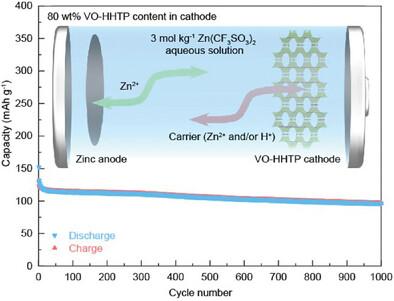Interconnected Lamellar 3D Semiconductive PCP for Rechargeable Aqueous Zinc Battery Cathodes
IF 13
2区 材料科学
Q1 CHEMISTRY, MULTIDISCIPLINARY
引用次数: 0
Abstract
2D electronically conductive porous coordination polymers/metal–organic frameworks (2D EC-MOFs) of M-HHTPs (HHTP = 2,3,6,7,10,11-hexahydroxytriphenylene; M = Co, Ni, Cu, etc.) have received extensive attention due to their ease of preparation, semiconductive properties, and tunability based on the choice of metal species. However, slight shifts between layers attenuate their specific surface area and stability. In this study, the metal-ion bridge strategy is newly adopted and a vanadyl counterpart of M-HHTP is synthesized with a chemical formula of (VO)3(HHTP)2, hereafter referred to as VO-HHTP. The semiconductor VO-HHTP has a vertical interconnection by octahedral VO6 chains and exhibits a relatively high specific surface area (ca. 590 m2 g−1) compared to other 2D EC-MOFs. Motivated by its redox activity and porous nature, VO-HHTP is applied as the cathode material in rechargeable aqueous zinc batteries (RAZBs). VO-HHTP demonstrates a high capacity of 240 mAh g−1 and excellent rate capability, even with a reduced amount of conductive agent, surpassing the performance of the previous EC-MOFs. Furthermore, its stable structure ensures long-term cycling stability, addressing a common issue in previous EC-MOFs. The work contributes to the development of new concepts in both the design of π-conjugated EC-MOFs and the study of cathode materials for RAZBs.

求助全文
约1分钟内获得全文
求助全文
来源期刊

Small
工程技术-材料科学:综合
CiteScore
17.70
自引率
3.80%
发文量
1830
审稿时长
2.1 months
期刊介绍:
Small serves as an exceptional platform for both experimental and theoretical studies in fundamental and applied interdisciplinary research at the nano- and microscale. The journal offers a compelling mix of peer-reviewed Research Articles, Reviews, Perspectives, and Comments.
With a remarkable 2022 Journal Impact Factor of 13.3 (Journal Citation Reports from Clarivate Analytics, 2023), Small remains among the top multidisciplinary journals, covering a wide range of topics at the interface of materials science, chemistry, physics, engineering, medicine, and biology.
Small's readership includes biochemists, biologists, biomedical scientists, chemists, engineers, information technologists, materials scientists, physicists, and theoreticians alike.
 求助内容:
求助内容: 应助结果提醒方式:
应助结果提醒方式:


